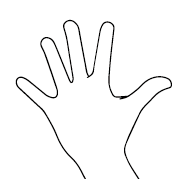TSL | Taiwan Sing Language Gleaning
Demonstratives
In TSL, signers often point straight fingers to refer to certain individuals, events, or locations, or draw an area to indicate plurals. These kinds of signs are known as demonstratives. When referring to a specific entity, the demonstrative is signed with one hand, and the pronoun with the other (or nouns and numbers that can act as pronouns). Signers also often designate a certain position in front of the body as representing certain entities and then point to it with straight fingers when they wish to refer to the entities.Here are several demonstratives (always signed with right hand):1. Indicating specific entities, such as you, I, they, there, here2. Indicating an area or a premise, such as location, inside the house, neighbors.3. Above or below a certain base level, or outside an area, such as above, below, more than 20, approximately, outside/other.4. Ordinal number, such as first (item).Demonstratives almost always concur with nouns or pronouns. Even if it occurs alone, it must be referring to an entity mentioned earlier or linked to a specific position or direction that refers to an entity.
Example sentence
- I am the youngest and Lao Wang is the oldest. Dr. Li is the second oldest. Lao Wang is 84 years old; Lao Li is 79 and I am 77.
- We grew up in Baihe. We are not real brothers but we are close.
- People living nearby said we are like brothers. We have done Tai Chi together for a long time. When people think of us, they all think we are close.
- Dr. Li, Lao Wang and I are always together.
- We usually do Tai Chi together. If one of us doesn't feel well, the other two will take him to see a doctor. We are close like real brothers. Lao Wang is the oldest, Lao Li is the second oldest and I am the youngest.










































































































